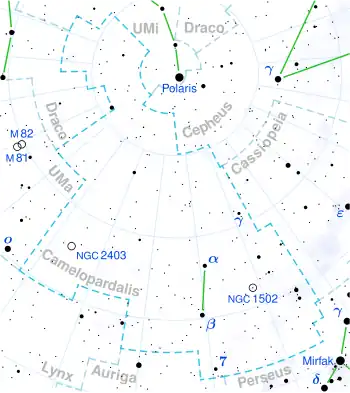 | |
| Observation data Epoch J2000.0 Equinox J2000.0 (ICRS) | |
|---|---|
| Constellation | Camelopardalis |
| Right ascension | 04h 06m 03.18286s[1] |
| Declination | +68° 40′ 47.8990″[1] |
| Apparent magnitude (V) | 5.86±0.01[2] |
| Characteristics | |
| Spectral type | M0 III[3] |
| B−V color index | +1.54[4] |
| Astrometry | |
| Radial velocity (Rv) | −48.23±0.26[5] km/s |
| Proper motion (μ) | RA: +7.555 mas/yr[1] Dec.: +2.938 mas/yr[1] |
| Parallax (π) | 5.4653 ± 0.0455 mas[1] |
| Distance | 597 ± 5 ly (183 ± 2 pc) |
| Absolute magnitude (MV) | −0.51[6] |
| Details | |
| Radius | 59.8+1.6 −1.5[7] or 39.6+1.2 −5.9[1] R☉ |
| Luminosity | 762+26 −22[1] L☉ |
| Surface gravity (log g) | 1.22[8] cgs |
| Temperature | 3,985±122[9] K |
| Metallicity [Fe/H] | −0.21±0.09[10] dex |
| Rotational velocity (v sin i) | 2.2±1.2[11] km/s |
| Other designations | |
| Database references | |
| SIMBAD | data |
HD 25274, also known as HR 1241, is a solitary star[13] located in the northern circumpolar constellation Camelopardalis. It is faintly visible to the naked eye as a red hued point of light with an apparent magnitude of 5.86.[2] Gaia DR3 parallax measurements imply a distance of 597 light-years and it is currently drifting closer with a heliocentric radial velocity of −48.23 km/s.[5] At its current distance, HD 25274's brightness is diminished by three-tenths of a magnitude due to interstellar extinction[14] and it has an absolute magnitude of −0.51.[6]
HD 25274 has a stellar classification of M0 III,[3] indicating that it is an evolved red giant. However, the Bright Star Catalog gives a hotter classification of K2 III.[15] The spectrophotometry-measured angular diameter, after correcting for limb darkening, is 2.02±0.03 mas.[16] At the estimated distance for HD 25274, this yields a physical radius 39.8 times that of the Sun.[17] It also has an empirical radius of 48.1 R☉[7] and Gaia DR3 models a larger radius.[1] The object radiates 762 times the luminosity of the Sun[1] from its enlarged photosphere at an effective temperature of 3,985 K.[9] HD 25274 is metal deficient with an iron abundance 62% that of the Sun's ([Fe/H] = −0.21)[10] and it spins modestly with a projected rotational velocity of 2.2 km/s.[11] HD 25274 is a field star of the HIP 21974 cluster.[18]
References
- 1 2 3 4 5 6 7 8 9 Vallenari, A.; et al. (Gaia collaboration) (2023). "Gaia Data Release 3. Summary of the content and survey properties". Astronomy and Astrophysics. 674: A1. arXiv:2208.00211. Bibcode:2023A&A...674A...1G. doi:10.1051/0004-6361/202243940. S2CID 244398875. Gaia DR3 record for this source at VizieR.
- 1 2 Høg, E.; Fabricius, C.; Makarov, V. V.; Urban, S.; Corbin, T.; Wycoff, G.; Bastian, U.; Schwekendiek, P.; Wicenec, A. (March 2000). "The Tycho-2 catalogue of the 2.5 million brightest stars". Astronomy and Astrophysics. 355: L27–L30. Bibcode:2000A&A...355L..27H. ISSN 0004-6361. S2CID 17128864.
- 1 2 Wilson, Ralph E.; Joy, Alfred H. (March 1950). "Radial Velocities of 2111 Stars". The Astrophysical Journal. 111: 221. Bibcode:1950ApJ...111..221W. doi:10.1086/145261. eISSN 1538-4357. ISSN 0004-637X. S2CID 122883647.
- ↑ Haggkvist, L.; Oja, T. (1970). "Results of BV photometry 1969-70 (Uppsala refractor)". Private Communication. Bibcode:1970Priv.........0H. S2CID 231475662.
- 1 2 Famaey, B.; Jorissen, A.; Luri, X.; Mayor, M.; Udry, S.; Dejonghe, H.; Turon, C. (January 2005). "Local kinematics of K and M giants from CORAVEL/Hipparcos/Tycho-2 data. Revisiting the concept of superclusters". Astronomy and Astrophysics. 430: 165. arXiv:astro-ph/0409579. Bibcode:2005A&A...430..165F. doi:10.1051/0004-6361:20041272. S2CID 17804304.
- 1 2 Anderson, E.; Francis, Ch. (May 2012). "XHIP: An extended hipparcos compilation". Astronomy Letters. 38 (5): 331–346. arXiv:1108.4971. Bibcode:2012AstL...38..331A. doi:10.1134/S1063773712050015. eISSN 1562-6873. ISSN 1063-7737. S2CID 119257644.
- 1 2 Kervella, Pierre; Arenou, Frédéric; Thévenin, Frédéric (2022). "Stellar and substellar companions from Gaia EDR3". Astronomy & Astrophysics. 657: A7. arXiv:2109.10912. Bibcode:2022A&A...657A...7K. doi:10.1051/0004-6361/202142146. eISSN 1432-0746. ISSN 0004-6361.
- ↑ McDonald, I.; Zijlstra, A. A.; Watson, R. A. (15 June 2017). "Fundamental parameters and infrared excesses of Tycho–Gaia stars". Monthly Notices of the Royal Astronomical Society. 471 (1): 770–791. arXiv:1706.02208. Bibcode:2017MNRAS.471..770M. doi:10.1093/mnras/stx1433. eISSN 1365-2966. ISSN 0035-8711. S2CID 73594365.
- 1 2 Stassun, Keivan G.; et al. (9 September 2019). "The Revised TESS Input Catalog and Candidate Target List". The Astronomical Journal. 158 (4): 138. arXiv:1905.10694. Bibcode:2019AJ....158..138S. doi:10.3847/1538-3881/ab3467. eISSN 1538-3881. hdl:1721.1/124721. S2CID 166227927.
- 1 2 Taylor, B. J. (February 1999). "Catalogs of temperatures and [Fe/H] averages for evolved G and K stars". Astronomy and Astrophysics Supplement. 134 (3): 523–524. Bibcode:1999A&AS..134..523T. doi:10.1051/aas:1999153.
- 1 2 de Medeiros, J. R.; Mayor, M. (November 1999). "A catalog of rotational and radial velocities for evolved stars". Astronomy and Astrophysics Supplement Series. 139 (3): 433–460. Bibcode:1999A&AS..139..433D. doi:10.1051/aas:1999401. ISSN 0365-0138. S2CID 54046583.
- ↑ "HD 25274". SIMBAD. Centre de données astronomiques de Strasbourg. Retrieved July 6, 2023.
- ↑ Eggleton, P. P.; Tokovinin, A. A. (11 September 2008). "A catalogue of multiplicity among bright stellar systems". Monthly Notices of the Royal Astronomical Society. 389 (2): 869–879. arXiv:0806.2878. Bibcode:2008MNRAS.389..869E. doi:10.1111/j.1365-2966.2008.13596.x. eISSN 1365-2966. ISSN 0035-8711. S2CID 14878976.
- ↑ Gontcharov, George A.; Mosenkov, Aleksandr V. (28 September 2017). "Verifying reddening and extinction for Gaia DR1 TGAS main sequence stars". Monthly Notices of the Royal Astronomical Society. 472 (4): 3805–3820. arXiv:1709.01160. Bibcode:2017MNRAS.472.3805G. doi:10.1093/mnras/stx2219. eISSN 1365-2966. ISSN 0035-8711. S2CID 118879856.
- ↑ Hoffleit, Dorrit; Jaschek, Carlos (1991). The Bright star catalogue. Bibcode:1991bsc..book.....H.
- ↑ Richichi, A.; Percheron, I.; Khristoforova, M. (February 2005). "CHARM2: An updated Catalog of High Angular Resolution Measurements". Astronomy & Astrophysics. 431 (2): 773–777. Bibcode:2005A&A...431..773R. doi:10.1051/0004-6361:20042039. eISSN 1432-0746. ISSN 0004-6361. S2CID 122267643.
- ↑ Lang, Kenneth R. (2006). Astrophysical formulae. Astronomy and astrophysics library. Vol. 1 (3rd ed.). Birkhäuser. ISBN 3-540-29692-1. The radius (R*) is given by:
- ↑ Cantat-Gaudin, T.; Jordi, C.; Vallenari, A.; Bragaglia, A.; Balaguer-Núñez, L.; Soubiran, C.; Bossini, D.; Moitinho, A.; Castro-Ginard, A.; Krone-Martins, A.; Casamiquela, L.; Sordo, R.; Carrera, R. (October 2018). "A Gaia DR2 view of the open cluster population in the Milky Way". Astronomy & Astrophysics. 618: A93. arXiv:1805.08726. Bibcode:2018A&A...618A..93C. doi:10.1051/0004-6361/201833476. ISSN 0004-6361.